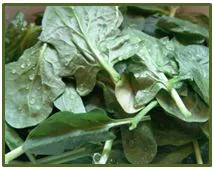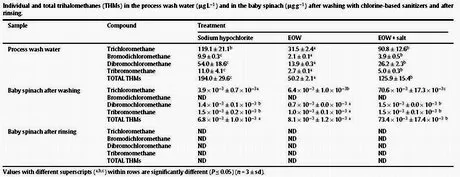 The potential generation of trihalometanes (THMs) during produce washing, as a consequence of the use of chlorine-based sanitizers, is one of the main current concerns for researchers, industry, and regulatory agencies.
The potential generation of trihalometanes (THMs) during produce washing, as a consequence of the use of chlorine-based sanitizers, is one of the main current concerns for researchers, industry, and regulatory agencies. However, there is poor information about the real THM formation during washing of fresh-cut produce in wash water and in the final product to prove the health and environmental risks related to THMs.
The THM formation is due to the reaction of chlorine with organic matter. This reaction can occur between chlorine and vegetable tissue, and between chlorine and washing water, which contains soil and organic matter (debris and exudates) released by vegetables. In addition, the vegetable can absorb THMs from washing water.
The scientists of the Department of Food Science and Technology at Murcia (Spain) have investigated the THM formation in washing water after washing baby spinach with chlorine-based sanitizer such as sodium hypochlorite and electrolyzed oxidizing water (EOW) with or without salt addition (EOW+NaCl or EOW, respectively). Moreover, the effects of these chlorine-based sanitizers on the microbial, sensorial, and nutritional quality of baby spinach was compared with peroxyacetic acid, which is a non-chlorine based sanitizer.
The total levels of THM in washing water treated with sodium hypochlorite and EOW+NaCl resulted over the limits fixed by EU legislation and USEPA (United States Environmental Protection Agency), according to which the THM limits for drinking water are 100 and 80 µg/L, respectively. The THM levels after EOW treatment did not exceed the established limits.
In regard to the fresh-cut baby spinach, the levels of THM in leaves resulted low in sodium hypochlorite and EOW washed samples because the rinsing operation reduced THM levels below the detection limit.
Click here to enlarge the table.

From comparison between chlorine-based sanitizers and peroxyacetic acid, no treatment affected the quality and the shelf-life of the product.
During washing and storage in MAP conditions, headspace gas concentration, microbial and sensorial quality, leaf texture, color, and leakage were measured for all treatments. Results showed that, under the experimental conditions used in this study, the chlorine-based sanitizers do not represent a risk for THM formation during baby spinach minimally processing.
The scientists conclude that this study will help to demystify the current and common idea on the risks of chlorine-based sanitizers use when baby spinach processing occurs in conditions similar to those of the present study.
Furthermore, from the economic point of view, chlorine-based sanitizers are the cheapest options among the current sanitation systems. Thus, this study could suggest the Countries, where sanitizers are not used because of legislation restrictions on chlorine use and the high costs of alternative sanitizers, to adopt water chlorination as standard sanitation practice to improve safety of their products.
Source: Gómez-López V.M., Marín A., Medina Martínez M.S., Gil M.I., Allende A., "Generation of trihalomethanes with chlorine-based sanitizers and impact on microbial, nutritional and sensory quality of baby spinach", Postharvest Biology and Technology, 2013, Vol. 85, pagg. 210-217. Further info: http://www.sciencedirect.com/science/article/pii/S0925521413001543
